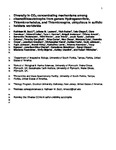Diversity in CO2 concentrating mechanisms among chemolithoautotrophs from genera Hydrogenovibrio, Thiomicrorhabdus, and Thiomicrospira, ubiquitous in sulfidic habitats worldwide
| dc.contributor.author | Scott, KM | |
| dc.contributor.author | Leonard, JM | |
| dc.contributor.author | Boden, Rich | |
| dc.contributor.author | Chaput, D | |
| dc.contributor.author | Dennison, C | |
| dc.contributor.author | Haller, E | |
| dc.contributor.author | Harmer, TL | |
| dc.contributor.author | Anderson, A | |
| dc.contributor.author | Arnold, T | |
| dc.contributor.author | Budenstein, S | |
| dc.contributor.author | Brown, R | |
| dc.contributor.author | Brand, J | |
| dc.contributor.author | Byers, J | |
| dc.contributor.author | Calarco, J | |
| dc.contributor.author | Campbell, T | |
| dc.contributor.author | Carter, E | |
| dc.contributor.author | Chase, M | |
| dc.contributor.author | Cole, M | |
| dc.contributor.author | Dwyer, D | |
| dc.contributor.author | Grasham, J | |
| dc.contributor.author | Hanni, C | |
| dc.contributor.author | Hazle, A | |
| dc.contributor.author | Johnson, C | |
| dc.contributor.author | Johnson, R | |
| dc.contributor.author | Kirby, B | |
| dc.contributor.author | Lewis, K | |
| dc.contributor.author | Neumann, B | |
| dc.contributor.author | Nguyen, T | |
| dc.contributor.author | Nino Charari, J | |
| dc.contributor.author | Morakinyo, O | |
| dc.contributor.author | Olsson, B | |
| dc.contributor.author | Roundtree, S | |
| dc.contributor.author | Skjerve, E | |
| dc.contributor.author | Ubaldini, A | |
| dc.contributor.author | Whittaker, R | |
| dc.date.accessioned | 2018-11-07T12:03:39Z | |
| dc.date.issued | 2019-02 | |
| dc.identifier.issn | 0099-2240 | |
| dc.identifier.issn | 1098-5336 | |
| dc.identifier.other | ARTN e02096-18 | |
| dc.identifier.uri | http://hdl.handle.net/10026.1/12732 | |
| dc.description.abstract |
Members of Hydrogenovibrio, Thiomicrospira and Thiomicrorhabdus fix carbon at hydrothermal vents, coastal sediments, hypersaline lakes, and other sulfidic habitats. The genome sequences of these ubiquitous and prolific chemolithoautotrophs suggest a surprising diversity of mechanisms for dissolved inorganic carbon (DIC) uptake and fixation; these mechanisms are verified here. Carboxysomes are apparent in transmission electron micrographs of most of these organisms; lack of carboxysomes in Thiomicrorhabdus sp. Milos T2 and Tmr. arctica, and an inability to grow under low DIC conditions by Thiomicrorhabdus sp. Milos T2 are consistent with an absence of carboxysome loci in their genomes. For the remaining organisms, potential DIC transporters from four evolutionarily distinct families (Tcr0853/0854, Chr, SbtA, SulP) are located downstream of carboxysome loci. Transporter genes collocated with carboxysome loci, as well as some homologs located elsewhere on the chromosomes, had elevated transcript levels under low DIC conditions, as assayed by qRT-PCR. DIC uptake was measureable via silicone oil centrifugation when a representative of each of the four types of transporter was expressed in Escherichia coli. Expression of these genes in carbonic anhydrase-deficient E. coli EDCM636 enabled it to grow under low DIC conditions, consistent with DIC transport by these proteins. The results from this study expand the range of DIC transporters within the SbtA and SulP transporter families, verify DIC uptake by transporters encoded by Tcr_0853 and Tcr_0854 and their homologs, and introduce DIC as a potential substrate for transporters from the Chr family. IMPORTANCE Autotrophic organisms take up and fix DIC, introducing carbon into the biological component of the global carbon cycle. The mechanisms for DIC uptake and fixation by autotrophic Bacteria and Archaea are likely to be diverse, but have only been well-characterized among "Cyanobacteria". Based on genome sequences, members of Hydrogenovibrio, Thiomicrospira and Thiomicrorhabdus have a variety of mechanisms for DIC uptake and fixation. We verified that most of these organisms are capable of growing under low DIC conditions, when they upregulate carboxysome loci and transporter genes collocated with these loci on their chromosomes. When these genes, which fall into four evolutionarily independent families of transporters, are expressed in E. coli, DIC transport is detected. This expansion in known DIC transporters across four families, from organisms from a variety of environments, provides insight into the ecophysiology of autotrophs, as well as a toolkit for engineering microorganisms for carbon-neutral biochemistries of industrial importance. | |
| dc.format.extent | e02096-e02018 | |
| dc.format.medium | Electronic-Print | |
| dc.language | en | |
| dc.language.iso | en | |
| dc.publisher | American Society for Microbiology | |
| dc.subject | CO2 concentrating mechanism | |
| dc.subject | chemolithoautotroph | |
| dc.subject | autotroph | |
| dc.subject | carbon fixation | |
| dc.title | Diversity in CO2 concentrating mechanisms among chemolithoautotrophs from genera Hydrogenovibrio, Thiomicrorhabdus, and Thiomicrospira, ubiquitous in sulfidic habitats worldwide | |
| dc.type | journal-article | |
| dc.type | Journal Article | |
| dc.type | Research Support, Non-U.S. Gov't | |
| dc.type | Research Support, U.S. Gov't, Non-P.H.S. | |
| plymouth.author-url | https://www.webofscience.com/api/gateway?GWVersion=2&SrcApp=PARTNER_APP&SrcAuth=LinksAMR&KeyUT=WOS:000456412800013&DestLinkType=FullRecord&DestApp=ALL_WOS&UsrCustomerID=11bb513d99f797142bcfeffcc58ea008 | |
| plymouth.issue | 3 | |
| plymouth.volume | 85 | |
| plymouth.publication-status | Published | |
| plymouth.journal | Applied and Environmental Microbiology | |
| dc.identifier.doi | 10.1128/AEM.02096-18 | |
| plymouth.organisational-group | /Plymouth | |
| plymouth.organisational-group | /Plymouth/Faculty of Science and Engineering | |
| plymouth.organisational-group | /Plymouth/Faculty of Science and Engineering/School of Biological and Marine Sciences | |
| plymouth.organisational-group | /Plymouth/REF 2021 Researchers by UoA | |
| plymouth.organisational-group | /Plymouth/REF 2021 Researchers by UoA/UoA06 Agriculture, Veterinary and Food Science | |
| plymouth.organisational-group | /Plymouth/Users by role | |
| plymouth.organisational-group | /Plymouth/Users by role/Academics | |
| dc.publisher.place | United States | |
| dcterms.dateAccepted | 2018-11-05 | |
| dc.rights.embargodate | 2019-7-23 | |
| dc.identifier.eissn | 1098-5336 | |
| dc.rights.embargoperiod | Not known | |
| rioxxterms.version | Accepted Manuscript | |
| rioxxterms.versionofrecord | 10.1128/AEM.02096-18 | |
| rioxxterms.licenseref.uri | http://www.rioxx.net/licenses/all-rights-reserved | |
| rioxxterms.licenseref.startdate | 2019-02 | |
| rioxxterms.type | Journal Article/Review |


